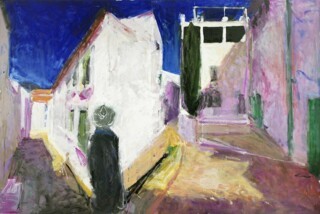The canvas went blue
Eleanor Birne
In the early 1970s, Sargy Mann – a student of Frank Auerbach and Euan Uglow, and the first postgraduate painting student at Camberwell Art School – was diagnosed with cataracts. He continued to paint, but he had to look much harder than most people. Eventually he went completely blind, but kept on painting. In the notes for a talk he was preparing before he died in May 2015, he explained that
if you look at the real world in front of you as intensely and as freely from visual preconceptions as you can and try to record as truthfully as you can what that experience is, you will in time see more, see better … And this belief, corroborated by experience, has been enough to keep me painting all my life and even into total blindness.
The late paintings – recently on show at the Royal Drawing School, curated by Chantal Joffe – were made in total blindness.
Mann describes travelling to Spain for inspiration:
In 2005 – almost completely blind again – I went to Cadaques in northern Spain with my son Peter. It was my perfect subject: deep blue sea, orange pantile roofs, all manmade surfaces painted blinding white and all in the Mediterranean sun. But I could see almost nothing and had Peter not been continuously by my side I would have plunged to my death on steps or ramps or over parapets. We explored Cadaques trying to find subjects … when I did find something I thought I could paint, Peter would describe it, and I would pace about measuring distances and heights and widths with my white stick.
He went home to Suffolk, ready to get to back to painting. But, following the sudden perforation of an ulcer in his left eye, he found himself thrown into the ‘total blindness’ he had ‘always dreaded’. In his studio,
I played through the Cadaques subjects in my memory – chose the most luminous and felt the canvas, thinking about what would go where, what the main divisions of the rectangle would be. Then, with excitement, but probably more trepidation, I put ultramarine on a brush and painted the top right hand corner of the canvas and I had one of the most extraordinary sensations of my life. I saw the canvas go blue. It wasn’t a projection, it wasn’t me remembering what it was like, it was a percept for sure, but a percept clearly created somewhere in my visual cortex.
Over the next eighteen months he painted all the Cadaques subjects and ‘largely forgot’ he was painting blind. Black Windows (2006) is a result of this process. It’s a view of a traditional Spanish street – white houses, green shutters, orange roofs – with a figure in a hat standing at the street corner gazing down. It’s hard not to see the figure as Mann himself, drinking in the scene the real man can’t. Green and white and shades of purple and yellow dance on the canvas. It’s the scene as felt recreated in paint, a sort of synaesthesia at work.
Many of the paintings have a strong feeling of warmth or heat about them, generated by the vibrancy of colour. In Infinity Pool III, three women in red, green and black bathing costumes lounge in a beach hut. The sun shines brightly on one of the seated figures; the other sits back in deep shade, her legs in the sun. The woman standing in front of the hut’s small window is painted in silhouette; her form casts a long shadow. Everything is languid, indolent – a holiday moment. In the right third of the painting, a woman stands on what looks like a verandah, the bright sea – two different blocks of blue – behind her. The sun hits the edge of her arm, her shoulder blade. A patch of sunshine glows on the outside wall of the hut. This is what sunlight feels like. It’s transporting to look at: Spanish summer heat and light summoned on a grey February day in Shoreditch.
Bonnard Drawing on the Pink Path is pure colourful expression (Mann was a devoted follower of Bonnard, going to see his show at the Royal Academy 24 times): a blocky line of white and coloured Mediterranean houses, a bright blue stream and a custard yellow path with bushes and trees in various shades of green and lilac in the distance. A dark figure wearing a white hat with his back to us looks out at it all. It’s rough and sketchy: the artist was, after all, feeling his way over the canvas with his brush and his hands. This is the essence of the scene, reduced down to first impressions of shape and sensed colour, rising up from memory.
